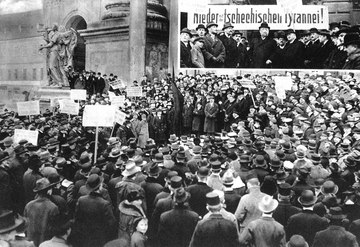One of the most important concerns which the German-Austrian delegation had when they set off for the peace conference in Paris was the inclusion in the newly founded republic of German-Austria of the areas of German settlement in the Sudeten lands.
According the law passed on 22 November 1918 regarding the frontiers of the republic of German-Austria, this was to include Austria below the river Enns (Lower Austria) with the district of German-South Moravia and the region around Neubistritz/Nová Bystřice, Austria above the river Enns (Upper Austria) with the district of German-South Bohemia as well as German-Bohemia, the Sudetenland and the German-speaking areas of Brünn/Brno, Iglau/Jihlava and Olmütz/Olomouc. However, this last group of territories was also claimed by the republic of Czechoslovakia, founded on 28 October 1918, which invoked the historical frontiers of Bohemia, Moravia and Silesia and presented arguments relating to the economy and the transport infrastructure.
The Czechoslovak government tried to create facts on the ground by occupying the German territories in question. It did not encounter much resistance, as the government in Vienna urged the avoidance of military conflicts, leaving the solution of border conflicts to the peace negotiations in Paris. The then Permanent Undersecretary for the army, Julius Deutsch, described the situation regarding military policy as follows:
… no military victory, however brilliant, would have been able to avert the damning pronouncement of the Entente. All we could do was to fight for our position in Paris and London. … the fight was decided on the day when the Czechs made a determined grab for their booty.
In Paris the Czech Foreign Minister Edvard Beneš told the Allied representatives that the territories Austria claimed did not include any purely German districts and that most of them were settled by a mixed language population. In addition he used historical, economic and strategic arguments to show that a strong Czechoslovakia could help to keep German influence in central Europe in check.
The Czechoslovak state was able to push through most of its territorial demands, above all because of the support of France. The peace conference decided to fix the pre-war administrative boundary between Bohemia and Moravia and the Austrian lands as the frontier of the republic of Czechoslovakia, and as a result three million German speakers were placed in Czechoslovakia. Protests by the German-Austrian government and the Sudeten Germans were ignored, as was the demand for a plebiscite. Consideration of the transport infrastructure led to the historical Czech frontiers being expanded still further to Austria’s disadvantage. In the area around Gmünd and Weitra some communities had to be ceded to Czechoslovakia, and alterations to the frontier were also made in the triangle between the rivers March and Thaya. It was the fact that Czechoslovak troops had fought on the side of the Entente and that the country’s claims did not conflict with the interests of the victorious states that provided the basis for such decisions. Thus in the case of the Bohemian lands it was not ethnic arguments but economic ties and the transport infrastructure that the Allies took into consideration. The principle of historical unity was ultimately given priority over that of national self-determination.
Translation: Leigh Bailey
Goldinger, Walter/Binder, Dieter A.: Geschichte der Republik Österreich 1918-1938, München 1992
Gutkas, Karl: Niederösterreich, in: Weinzierl, Erika/Skalnik, Kurt (Hrsg.): Österreich 1918-1938. Geschichte der Ersten Republik, Bd. 2, Graz/Wien/Köln 1983, 841-872
Haider, Siegfried: Geschichte Oberösterreichs, Wien 1987
Hummelberger, Walter: Die niederösterreichisch-tschechoslowakische Grenzfrage 1918/19, in: Ackerl, Isabella/Neck, Rudolf (Hrsg.): Saint-Germain 1919. Protokoll des Symposiums am 29. und 30. Mai 1979 in Wien, Wien 1989, 78-111
Komlosy, Andrea/Bůžek, Václav/Svátek, František (Hrsg.): Kulturen an der Grenze. Waldviertel – Weinviertel – Südböhmen – Südmähren (interdisziplinäres österreichisch-tschechisches Forschungs- und Ausstellungsprojekt), Wien 1995
Reichel, Walter: Tschechoslowakei-Österreich. Grenzziehung 1918-1919, in: Konrad, Helmut/Maderthaner, Wolfgang (Hrsg.): Das Werden der Ersten Republik … der Rest ist Österreich. Bd. I, Wien 2008, 159-178
Scheuch, Manfred: Historischer Atlas Österreich, 6. Auflage, Wien 2008
Slapnicka, Harry: Oberösterreich, in: Weinzierl, Erika/Skalnik, Kurt (Hrsg.): Österreich 1918-1938. Geschichte der Ersten Republik, Bd. 2, Graz/Wien/Köln 1983, 873-902
Welisch, Sophie A.: Die Sudetendeutsche Frage 1918-1928, München 1980
Zöllner, Erich: Geschichte Österreichs. Von den Anfängen bis zur Gegenwart, 8. Auflage, Wien/München 1990
Quotes:
"… no military victory ...": Deutsch, Julius: Aus Österreichs Revolution. Militärpolitische Erinnerungen, Wien ohne Jahr (1921), 67f. quoted from: Hummelberger, Walter: Die niederösterreichisch-tschechoslowakische Grenzfrage 1918/19, in: Ackerl, Isabella/Neck, Rudolf (Hrsg.): Saint-Germain 1919. Protokoll des Symposiums am 29. und 30. Mai 1979 in Wien, Wien 1989, 95 (Translation)
-
Chapters
- The High Price of Peace
- Tyrol Is Divided
- Burgenland Is Gained
- The defensive campaign in Carinthia and the plebiscite on 10 October 1920
- Losing Southern Styria
- Fixing the Northern Frontier
- Austrian Federal Province or Swiss Canton?
- Austrian attempts to unite with Germany from the founding of the republic to the referendums in Tyrol and Salzburg in 1921




